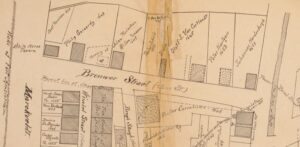Stephanus Van Cortlandt, Mayor 1677-1678 and 1687-1689
Oloff Stevense Van Cortlandt (c. 1615–1684) was the founder of the Van Cortlandt family and arrived in New Amsterdam in 1637 as an officer of the Dutch West India Company, then became an inspector of tobacco, followed by Commissary of Cargos. He served as burgomaster (office similar to mayor held by two men) many times (1655-1656, 1658-1659, 1662-1663, and 1665) and was known for his opposition to the policies of Director General Peter Stuyvesant. He was a distiller, brewer, and merchant who became one of the wealthiest men in New Netherland. He was one of the six Dutch who negotiated the surrender to the English. He was an enslaver.[1] In a December 17, 1646 contract, Oloff leased a farm on Manhattan and “promises to have the new plantation, or the land on which the Negroes dwell, cleared at his expense and made fit for the plow…”[2] In 1652, he signed the same petition as Cornelius Steenwyck explaining that the inhabitants of New Amsterdam were “inclined to a foreign trade, and especially the coast of Africa” to “fetch thence slaves.”[3]

Map of the East River shore in 1655, Oloff Van Cortlandt house on Stone Street, J.H. Innes, 1902, New Amsterdam and Its People
His sons, Stephanus and Jacobus, both served as mayor and were intermarried with several other influential New York families. Stephanus was the first native-born mayor and Jacobus established a plantation in 1693 in what is now the Bronx.
Stephanus Van Cortlandt (1643 – 1700) was a wealthy merchant. He was a partner in the illegal slave trade with Madagascar with his brother-in-law Robert Livingston and in trade between Amsterdam, London, Barbados, Nevis, St. Christopher, Curaçao, and New York; sold enslaved people in New York; supplied the English military with provisions; engaged in the fur trade; and shipped dye.[4]
Stephanus lived in New York City on Brewer’s Street. Stephanus was granted 86,000 acres of land by Governor Benjamin Fletcher in June 1697. It became Van Cortlandt manor (Westchester County) and was divided among his children upon his death.[5] Fletcher also gave Stephanus Sagtikos Manor on Long Island’s south shore.
He had a business partnership with Robert Livingston, one of the most prominent slave traders in the colony. In 1678, Stephanus began importing goods for Livingston to sell in his store in Albany.[6] In 1690, Livingston wrote in a letter that they were partners in the ship Margriet, which sailed from New York to Madagascar, Barbados, and Virginia, carrying rice and then enslaved people and sugar.[7] New York merchants bought enslaved people in Madagascar at this time to avoid the Royal African Company’s monopoly on captives sold from West Africa. The East India Company had rights to trade with Madagascar and struggled to stop piracy there, especially in the slave trade, until an act of parliament in 1698.[8]
Stephanus sold the enslaved. On November 15, 1691, Stephanus wrote to Robert Livingston that he sold an enslaved boy to Kiliaen van Rensselaer.[9] Van Cortlandt also extended credit on sales to secure favors:
If you can, let Rensselaer, too, provide the people with small beer. He got a negro-boy from me and thus it will be easy for him and me to settle with each other. I hope Leverits will supply you with pork or something else for what he owes me; and the brewer’s widow at Schenectady as well, who owes me £27 for a negro. I never in all my life had as much difficulty in raising money as now.[10]
Slaveship Investment
| Ship | In NY Port | Ports of Call | Enslaved Purchased | Cargo | Co-Investor |
| Margriet | 1690 | To Madagascar, Barbados, and Virginia. | unknown | Outward: rice; Return: sugar and tobacco | Robert Livingston |
[1] “Burghers and Blacks,” p.132
[2] New Amsterdam History Center, Oloff Stevensen Van Cortlandt; Museum of the City of New York, New Amsterdam Educator Resource Guide; New Netherland Institute, Volume II, Register of the Provincial Secretary, 1642-1647, p.384
[3] Original document from NY State Archives
[4] Merchants & Empire, p. 60, 64, 95, 147, 189, 222; Bound by Bondage, p.83
[5] The Van Cortlandt Family, p.11; NYG&B, New York Researcher, Fall 1999, p.56; NYG&B Record, July 1874: Volume 5, issue 3, p.16; October 1918: Volume 49, issue 4, p.369
[6] Robert Livingston and the Politics of Colonial New York, 1654-1728, Lawrence H. Leder, p.37-39
[7] Robert Livingston and the Politics of Colonial New York, p.90, n.35; In letter: Rek van ship de Margriet van Madakasker naer Barbados & nae Virginia, The Gilder Lehrman Collection, GLC03107.00179; For these voyages, Leder states that Livingston’s share was 4,591 florins and his net profit was 1,745 florins. It is unclear from Livingston’s account if this is correct.
[8] “The East India Company and the Madagascar Slave Trade,” Virginia Bever Platt, The William and Mary Quarterly, Vol. 26, No. 4, Oct., 1969,
[9] Bound by Bondage, p.79
[10] “Bound by Bondage,” dissertation, Maskiell, 2013 p.252
Slaveship: Robert Livingston and the Politics of Colonial New York, p.90, n.35; Traders and Gentlefolk, p.39



